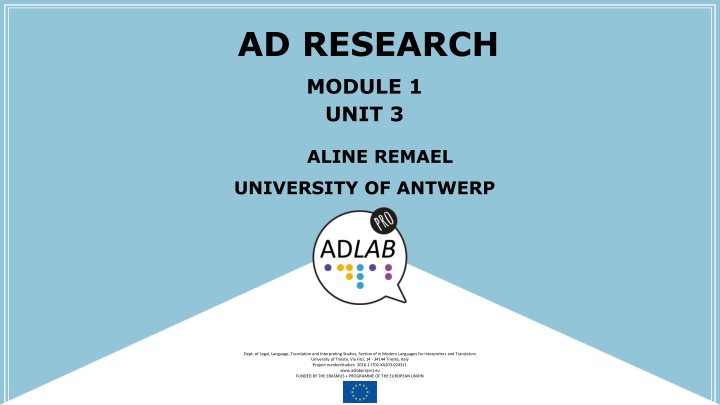
AD Research and Its Link with Industry and Practice
Dive into the academic discipline of AD research, exploring its conceptual framework, integration into university programs, sub-disciplines within Audiovisual Translation and Media Accessibility, and its unique connection to industry, stakeholders, legislation, and innovation.
Download Presentation

Please find below an Image/Link to download the presentation.
The content on the website is provided AS IS for your information and personal use only. It may not be sold, licensed, or shared on other websites without obtaining consent from the author. If you encounter any issues during the download, it is possible that the publisher has removed the file from their server.
You are allowed to download the files provided on this website for personal or commercial use, subject to the condition that they are used lawfully. All files are the property of their respective owners.
The content on the website is provided AS IS for your information and personal use only. It may not be sold, licensed, or shared on other websites without obtaining consent from the author.
E N D
Presentation Transcript
AD RESEARCH MODULE 1 UNIT 3 ALINE REMAEL UNIVERSITY OF ANTWERP Dept. of Legal, Language, Translation and Interpreting Studies, Section of in Modern Languages for Interpreters and Translators University of Trieste, Via Filzi, 14 - 34144 Trieste, Italy Project numberStudies: 2016-1-IT02-KA203-024311 www.adlabproject.eu FUNDED BY THE ERASMUS + PROGRAMME OF THE EUROPEAN UNION
INTRODUCTION AD academic discipline since turn of 21st century.
INTRODUCTION conceptual framework, publications and conferences, integrated into university programmes.
AVT AND MA AD research can also be seen as a sub-discipline of Audiovisual Translation and/or Media Accessibility.
AVT AND MA Both disciplines study translation for audiovisual texts and are virtually indistinguishable.
AVT AND MA Both disciplines encompass interlingual, intralingual and intersemiotic translation.
LINK WITH INDUSTRY AND PRACTICE Very specific to AD research is its link with practice, industry, stakeholders, legislation and technical innovation.
CYCLICAL DEVELOPMENT Diversification of research topics and methods. Early research questions from 1990s often re-examined more empirically.
AD AS A TEXT TYPE Early research by practitioners and academics was analytical-descriptive.
AD AS A TEXT TYPE AD as a text type, Screen AD: its nature and challenges.
IDENTIFYING WHAT TO INCLUDE AND HOW Early research also focused on guidelines and how to tackle the wealth of information in multimodal texts.
IDENTIFYING WHAT TO INCLUDE AND HOW It focused on content selection.
IDENTIFYING WHAT TO INCLUDE AND HOW what to include in AD, how much to include in AD,
IDENTIFYING WHAT TO INCLUDE AND HOW when to include information, how to include information,
IDENTIFYING WHAT TO INCLUDE AND HOW issues of objectivity, the possibility of equivalence in AD.
NATIONAL DEVELOPMENTS AD at different speeds in different regions: studies on national and regional traditions.
TECHNOLOGY AND METHODOLOGY Initial research often intuitive: practice-based, small focus groups, limited case studies.
TECHNOLOGY AND METHODOLOGY Technology: large, digitized multimodal corpora, increase in experimental and empirical research.
RECEPTION RESEARCH Benefits greatly from technology: eyetracking, electrocephalography, to measure audience reactions.
RECEPTION RESEARCH Result: accurate information on audience preferences and AD functioning.
INTERDISCIPLINARITY Interdisciplinarity and collaboration with many different disciplines is now central to AD research.
INTERDISCIPLINARITY Much research is project research aiming at large-scale solutions for industry and users.
MAINSTREAMING AND QUALITY Optimizing production, minimizing costs: machine translation and artifical voices. Guaranteeing the quality of the AD product.
UNIVERSAL DESIGN Products designed to benefit everyone from inception.
UNIVERSAL DESIGN AD as part of the creative process, for instance, in theatre and film.
UNIVERSAL DESIGN Merger of AD research with accessibility studies.
CONCLUSION A bird s eye view of AD research.
AD RESEARCH MODULE 1 UNIT 3 ALINE REMAEL UNIVERSITY OF ANTWERP Dept. of Legal, Language, Translation and Interpreting Studies, Section of in Modern Languages for Interpreters and Translators University of Trieste, Via Filzi, 14 - 34144 Trieste, Italy Project numberStudies: 2016-1-IT02-KA203-024311 Edited by: editor s first and last name www.adlabproject.eu FUNDED BY THE ERASMUS + PROGRAMME OF THE EUROPEAN UNION
The preparation of this presentation was supported by ADLAB PRO (Audio Description: A Laboratory for the Development of a New Professional Profile), financed by the European Union under the Erasmus+ Programme, Key Action 2 Strategic Partnerships, Project number:2016-1-IT02-KA203-024311.
The information and views set out in this presentation are those of the authors and do not necessarily reflect the official opinion of the European Union. Neither the European Union institutions and bodies nor any person acting on their behalf may be held responsible for the use which may be made of the information contained therein.






















